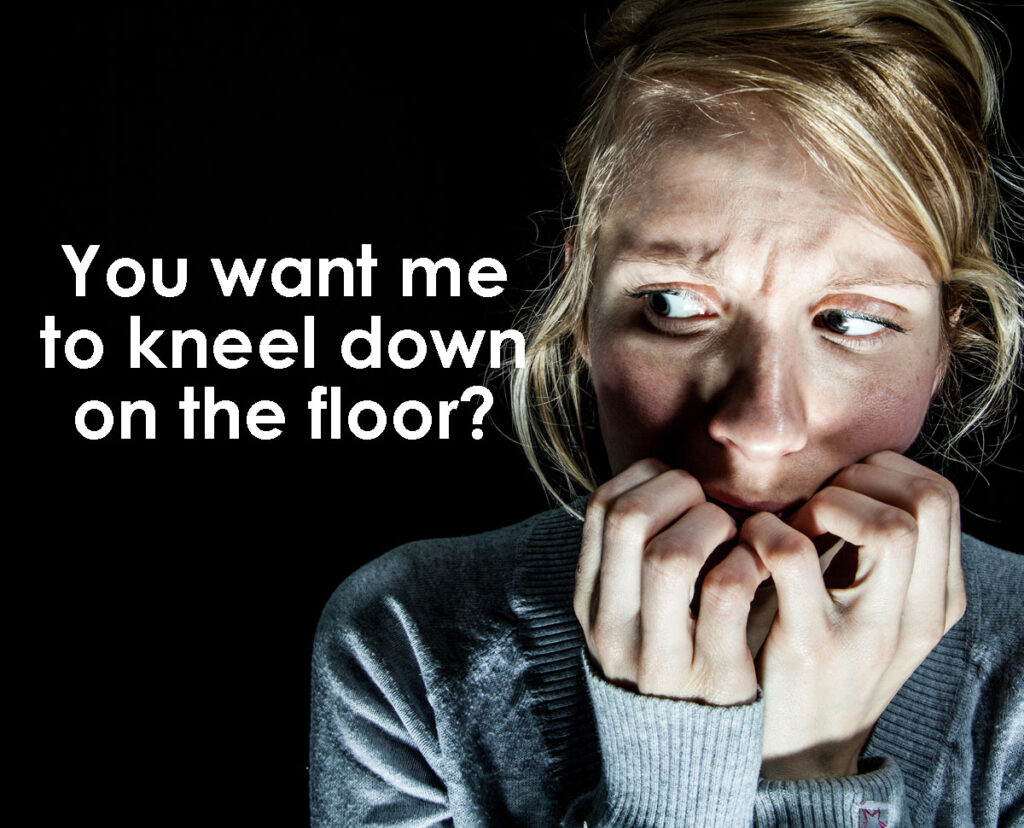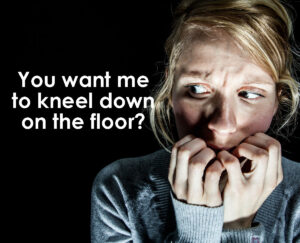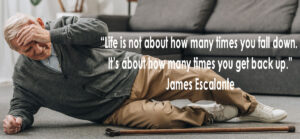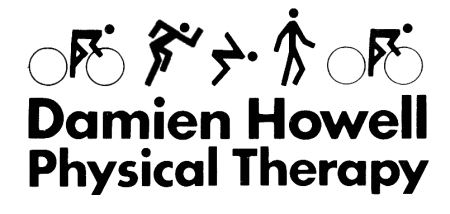What is the alternative to I have fallen, & I can’t get up? – improve strengthen flexibility “just do it”

A patient with Parkinson’s syndrome, living alone expressed to me his frustration. He had fallen and was unable to get back up. He pissed on himself. He used his fall alert system via the internet to notify the rescue squad. In addition to the embarrassment, he felt about not being able to get back up what was particularly frustrating for him was the cost of replacing the deadbolt lock on the front door that the rescue squad destroyed. Over a series of physical therapy home visits, which included functional activity of practicing the challenging activity of floor transfer the floor has become his friend. See how the floor has become his friend later in this essay.

It takes me aback when I ask a patient to kneel on the floor or lie on their back on the floor to do an exercise, and the patient responds, “I can’t do that.”
After I stifle my dismissive thoughts, I continue with questions to try to get a better understanding of my patient’s reasoning. Often the response is “I have a knee replacement” or “My knee is bone-on-bone arthritis”.
There is currently no evidence that there is any clinical reason why patients should not kneel on their replaced knee (Wylde, Vikki 2019)
“We have nothing to fear but fear itself”.
Franklin Roosevelt
Perhaps the fear of kneeling is worse than the actual kneeling.
Allowing the fear of kneeling to prevent us from accessing the floor may be more harmful than the actual challenge of getting to and from it.
It is very common to see discrepancies between a patient’s self-reported level of disability and their actual observed performance of a function. (Reiman, Michael 2011) Discrepancies between an individual’s self-report abilities to kneel and the actual observed performance suggest that individuals can kneel but elect not to. The reasons for this are multifactorial.
Why might someone have a fear of kneeling on the floor?
- Kneeling gradually became difficult and uncomfortable
- Potential pain from previous injury or surgery
- Some healthcare providers advise patients not to kneel. (Benfayed, R. 2017).
- Fear of damaging joint replacement prothesis
- Fear worsening bone-on-bone pain pre-existing arthritis
- Fear of not being able to get back up
A study found that most patients do not speak to healthcare professionals about their difficulty kneeling. (Fletcher, D 2019)
Many patients don’t discuss difficulty kneeling with their healthcare provider because:
- They consider it a minor issue
- Because they believe their fear of kneeling is a normal part of aging
- Fear of being judged for not being active enough
- Worry about being seen as weak
- Fail to recognize treatment options are available
- They do not think that their limitations are sufficiently severe enough to seek healthcare
- Poor communication with the healthcare provider
Kneeling is an important function. It's also good to be able to get to and from the floor, as the floor can be your friend.
Having access to the floor facilitates daily self-care activities, participation in religious rituals (Muslim prayer or Salah, genuflection), playing with pets, and other recreational/social activities.
Lying on a firm/hard surface like the floor:
- Facilitates sensory input/feedback for large portions of the body helping to refine awareness of alignments and subtle movements.
- Provides a consistent reference benchmark regarding spinal/postural alignment.
- Yoga, meditation, and Feldenkrais movement therapy are done on the floor. Dr. Moshe Feldenkrais said “that the floor acts as a mirror to help us complete our self-image.
- Allowing full-body stretching promotes relaxation by reducing muscle tension.
- Provides an opportunity for the self-mobilization of joints and soft tissues. Self-manipulation/mobilization of the spine/joints is performed on the floor. To appropriately use a foam roll device requires transferring to and from the floor
- It feels good.
An alternative to falling and not being able to get back up is:
If you have fallen and are not able to get up off the floor; have a fear of kneeling; have had orthopedic surgery; or know that kneeling is a difficult; uncomfortable activity/function; then either ask Dr. Google for help and start practicing floor transfer, and/or ask for a consultation with a Physical Therapist.
Ask Dr. Google how to do floor transfer and start practicing. Search YouTube and use the keyword “how to do floor transfer”.

Here are a few examples.
Exercise – Graded Exposure to Kneeling
How to get up & down from floor – Feldenkrais style
Request a consultation with a Physical Therapist to improve the function of floor transfer.
Do not feel embarrassed to share with a healthcare professional any fear of kneeling or getting to and from the floor.
If you are seeing a Physical Therapist for pain or a disability the therapist may ask you to complete a “patient-specific functional scale report”. For the self-report activity choose “getting off the floor”. The patient-specific functional scale asks on a scale of zero to 10 if you feel you have no issues which is a score of zero or if you feel you cannot perform the activity which is a score of 10.
A Physical Therapist can outline appropriate strengthening and flexibility exercises and functional activity progression necessary to get to and from the floor. The Physical Therapist can identify appropriate functional progression or graded progression of the transfer, desensitization of any phobia or fear of the floor, and appropriate adaptive equipment.
“Life is not about how many times you fall down. It’s about how many times you get back up”
James Escalante

The information on this website is not intended or implied to be a substitute for professional medical advice, diagnosis, or treatment. You are encouraged to perform additional research regarding any information contained available through this website with other sources and consult with your physician.
Damien Howell Physical Therapy – 804-647-9499 – Fax: 866-879-8591 At-Home, At Office, At Fitness Facility – I come to you, I do home visits Damien@damienhowellpt.com
